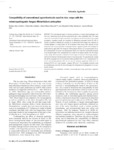Please use this identifier to cite or link to this item:
http://www.alice.cnptia.embrapa.br/alice/handle/doc/959161Full metadata record
| DC Field | Value | Language |
|---|---|---|
| dc.contributor.author | SILVA, R. A. da | pt_BR |
| dc.contributor.author | QUINTELA, E. D. | pt_BR |
| dc.contributor.author | MASCARIN, G. M. | pt_BR |
| dc.contributor.author | BARRIGOSSI, J. A. F. | pt_BR |
| dc.contributor.author | LIÃO, L. M. | pt_BR |
| dc.date.accessioned | 2013-06-03T11:11:11Z | pt_BR |
| dc.date.available | 2013-06-03T11:11:11Z | pt_BR |
| dc.date.created | 2013-06-03 | pt_BR |
| dc.date.issued | 2013 | pt_BR |
| dc.identifier.citation | Scientia Agricola, Piracicaba, v. 70, n. 3, p. 152-160, maio/jun. 2013. | pt_BR |
| dc.identifier.uri | http://www.alice.cnptia.embrapa.br/alice/handle/doc/959161 | pt_BR |
| dc.description | The toxicological impact of chemical pesticides on fungal entomopathogens and their use in tank-mixing can be directly measured through in vitro compatibility tests. This study reports the in vitro toxicity of eight insecticides, four fungicides and five herbicides in the conidial germination, vegetative growth and conidiation of Metarhizium anisopliae (strain CG 168). A conidial suspension containing the pesticide at recommended field dosage was subjected to constant agitation in a rotary shaker for 3h to simulate a tank mixing. Then, aliquots of each suspension were used to determine conidial germination, vegetative growth and conidiation on potato dextrose agar (PDA). The fungicides difenoconazole (69 mL ha?1), propiconazole (75 mL ha?1), trifloxystrobin (313 g ha?1) and azoxystrobin (56 mL ha?1) were the most harmful products to all biological stages of M. anisopliae and they should not be applied together with this fungus in tank mixing. The insecticides exhibited the least degree of toxicity to this fungal pathogen, whereas the herbicides had the greatest impact on mycelial growth. The agrochemicals compatible with M. anisopliae were the insecticides methyl parathion (240 mL ha?1), thiamethoxam (31 g ha?1), and lambda-cyhalothrin (6.3 mL ha?1) and the herbicides glyphosate (1560 mL ha?1), bentazon (720 mL ha?1), and imazapic+ imazapyr (84 g ha?1). The compatible pesticides could be simultaneously used with this bio-control agent for integrated pest management in rice production systems. | pt_BR |
| dc.language.iso | eng | eng |
| dc.rights | openAccess | eng |
| dc.title | Compatibility of conventional agrochemicals used in rice crops with the entomopathogenic fungus Metarhizium anisopliae. | pt_BR |
| dc.type | Artigo de periódico | pt_BR |
| dc.date.updated | 2013-10-18T11:11:11Z | pt_BR |
| dc.subject.thesagro | Arroz | pt_BR |
| dc.subject.thesagro | Oryza sativa | pt_BR |
| dc.subject.thesagro | Conídio | pt_BR |
| dc.subject.thesagro | Germinação | pt_BR |
| dc.subject.thesagro | Metarhizium anisopliae | pt_BR |
| dc.subject.thesagro | Fungo | pt_BR |
| riaa.ainfo.id | 959161 | pt_BR |
| riaa.ainfo.lastupdate | 2013-10-18 | pt_BR |
| dc.contributor.institution | RODRIGO ALVES DA SILVA, CNPAF; ELIANE DIAS QUINTELA, CNPAF; GABRIEL MOURA MASCARIN, CNPAF; JOSE ALEXANDRE F BARRIGOSSI, CNPAF; LUCIANO MORAES LIÃO, UFG. | pt_BR |
| Appears in Collections: | Artigo em periódico indexado (CNPAF)  | |
Files in This Item:
| File | Description | Size | Format | |
|---|---|---|---|---|
| scientia.pdf | 900 kB | Adobe PDF |  View/Open |









